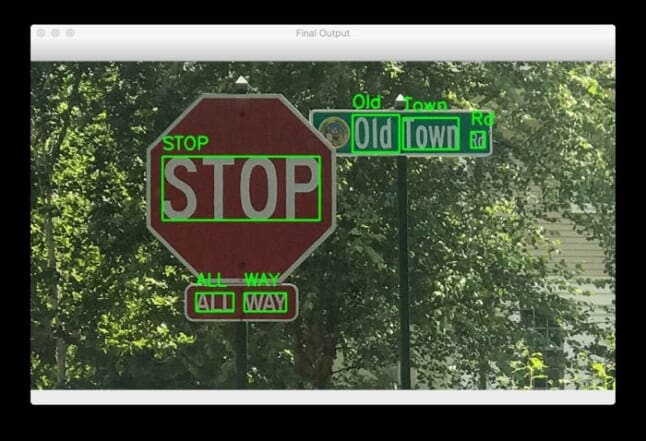Are you tired of hearing buzzwords like “Machine Learning”, “Large Language Models”, and “AGI” everywhere you go, without understanding what they actually mean? If so, you’ve come to the right place.
At PyImageSearch, we specialize in breaking down these complex topics into easy-to-understand short tutorials. Read on for a gentle introduction to machine learning and deep learning for computer vision, which will give you the perfect map for navigating these topics.
Also, you might want to check out our computer vision for deep learning program before you go.
Machine Learning for Computer Vision
Picture this: you can use face detection algorithms to locate human faces in images or videos, perfect for automated tagging and organization of all your selfies (you know you have a ton of them).
Or how about image generation, where you can use machine learning to create completely new images that look like they were snapped by a pro photographer (no offense to your skills, of course)?
And don’t get me started on Optical Character Recognition or OCR, where you can use machine learning to digitize and analyze text-based information in images – say goodbye to manual data entry!
And if you’re really into the advanced stuff, you can use techniques like neural radiance fields or 3D volumetric rendering to create super-realistic 3D models of objects and scenes.
That’s right; you can create virtual worlds that are so detailed and accurate that you’ll feel like you’re there (okay, maybe not that realistic, but pretty close!).
Fun Fact: The below image👇 was generated through machine learning.
What is Machine Learning?
So what is Machine Learning? Is it an exact science? How do we define it?
Machine learning (ML) is a field of inquiry devoted to understanding and building methods that “learn” – that is, methods that leverage data to improve performance on some set of tasks. It is seen as a part of artificial intelligence.
– Wikipedia
Learning to ride a bike is a process that most of us have experienced. At first, we rely on the support of our parents or friends as they hold the bike steady while we attempt to pedal and maintain our balance. Gradually, with practice, we become better at riding until we can confidently do it on our own. We have successfully learned a new skill!
Machine learning is like teaching a computer to “ride a bike”.
Researchers and developers aim to enable computers to learn from experience, much like we do. They provide the computer with many examples and data, analogous to observing many bike rides. The computer then processes this information and refines its abilities, improving its performance over time, just as we did while learning to ride a bike.
Ultimately, the computer becomes proficient at the task, whether playing a game, recognizing images, or even assisting with complex tasks. Machine learning empowers computers to learn and become more intelligent, contributing to the ever-evolving technological landscape that enriches our lives.
Types of Machine Learning
Machine learning encompasses several strategies that teach algorithms to recognize patterns in data, guiding informed actions in similar settings. These strategies include:
- Supervised Learning: It’s like having a teacher who shows you examples and corrects your mistakes. The computer learns from a data set with questions and answers.
Examples: image classification and time-series classification. - Unsupervised Learning: It’s like exploring a new playground without a guide. The computer finds patterns and groups in data without knowing the answers.
Examples: image clustering and semantic image clustering. - Semi-Supervised Learning: It’s like learning with some help from a teacher and some self-discovery. The computer learns from a mix of data, some with answers and some without.
Examples: neural machine translation, semi-supervision, and domain adaptation. - Reinforcement Learning: It’s like learning to ride a bike by trial and error. The computer learns by making decisions, getting feedback, and adjusting its actions.
Examples: teaching a cartpole to balance itself. - Transfer Learning: It’s like using what you know in math class to solve a science problem. The computer takes knowledge from one area and applies it to another, similar area.
Examples: transfer learning and image classification.
You can learn more about these strategies and rules in a hands-on manner in our comprehensive Machine Learning in Python blog post.
What is Computer Vision?
Computer vision is a field of artificial intelligence (AI) that enables computers and systems to derive meaningful information from digital images, videos, and other visual inputs — and take actions or make recommendations based on that information. If AI enables computers to think, computer vision enables them to see, observe and understand.
-IBM
Computer vision is a part of artificial intelligence that helps computers “see” and understand images, videos, and other visuals. It’s like giving computers a pair of eyes to make sense of what’s happening in pictures and videos.
This helps them take action or make suggestions based on what they see. In other words, computer vision allows computers to analyze and learn from the visual world, just like we do with our own eyes.
An example of a computer vision application is facial recognition technology. This technology is used in various areas, such as:
- Face Recognition: Facial recognition systems can be employed in security cameras to identify and track individuals in public spaces or restricted areas, enhancing safety and monitoring.
- Mask Detector: These systems can automatically detect whether an individual is wearing a mask. Automating regulation and safety.
- Age Detection: Using computer vision algorithms, there are now algorithms to correctly analyze and predict age from facial features.
If you are interested in learning more about facial recognition technology as a subfield of Computer Vision, we at PyImageSearch have a whole section dedicated to Facial Applications. Be sure to check that out here.
Other computer vision applications include autonomous vehicles, where the technology helps the car “see” and navigate its environment, and medical imaging, where it assists in diagnosing diseases by analyzing medical images such as X-rays and MRIs.
Machine Learning for Computer Vision
As machine learning and computer vision are subfields of Artificial intelligence, what’s the logical next step?
Machine learning for computer vision uses algorithms to teach computers to analyze and understand visual information, such as images and videos.
By feeding a large amount of labeled data into the machine learning model, the computer can learn patterns, features, and relationships within the visual data, making predictions or taking actions when presented with new, unseen data.
Machine learning algorithms have thus significantly improved the performance and accuracy of computer vision tasks.
Examples of machine learning applications in computer vision include:
- Object detection and recognition:
- Machine learning models can be trained to identify and classify objects within images or videos.
- This can be applied to various industries, such as retail (inventory management), agriculture (crop monitoring), and manufacturing (quality control).
- Image segmentation:
- This involves dividing an image into different segments, allowing for a more detailed analysis of each part.
- It can be used in medical imaging to identify and isolate specific areas of interest, such as tumors or blood vessels, or in autonomous vehicles to differentiate between road surfaces, pedestrians, and other vehicles.
- Scene understanding:
- Machine learning models can be trained to comprehend the context of an image or video by recognizing and analyzing multiple elements, such as objects, people, and backgrounds.
- This can be useful in areas like video surveillance, where understanding the context of a scene can help detect unusual or suspicious activities.
- Facial recognition and analysis:
- Machine learning techniques can identify individuals, detect emotions, or estimate age and gender.
- These capabilities have applications in security and surveillance, personalized marketing, and even entertainment industries, like video games and virtual reality experiences.
Machine Learning has given way to Deep Learning, which is a new subfield where we stack neural networks ( a building block that is comprised of matrices) on top of each other to achieve advanced image processing.
This new field Deep Learning for Computer Vision is a rapidly advancing field with new research releasing every day. We have compiled the most beginner friendly blogposts to get started and published it here.
Conclusion
In conclusion, machine learning and computer vision have revolutionized the way we interpret and interact with the world around us. As these technologies continue to advance, they will unlock new possibilities and capabilities that were once unimaginable. By combining powerful algorithms, vast amounts of data, and the relentless pursuit of innovation, we have witnessed significant improvements in image recognition, object detection, and semantic understanding. This synergy has the potential to transform industries, enhance human experiences, and tackle some of the world’s most pressing challenges.
As we embrace the future of machine learning and computer vision, it is crucial that we remain mindful of the ethical implications and work collaboratively to ensure the responsible and equitable development of these groundbreaking tools. The future is bright, and we have only just begun to scratch the surface of what is possible with machine learning and computer vision at our fingertips.
If you want a structured approach to mastering computer vision and machine learning, and want to stay updated with the latest research, news articles and much more, be sure to check out PyImageSearch University.










Comment section
Hey, Adrian Rosebrock here, author and creator of PyImageSearch. While I love hearing from readers, a couple years ago I made the tough decision to no longer offer 1:1 help over blog post comments.
At the time I was receiving 200+ emails per day and another 100+ blog post comments. I simply did not have the time to moderate and respond to them all, and the sheer volume of requests was taking a toll on me.
Instead, my goal is to do the most good for the computer vision, deep learning, and OpenCV community at large by focusing my time on authoring high-quality blog posts, tutorials, and books/courses.
If you need help learning computer vision and deep learning, I suggest you refer to my full catalog of books and courses — they have helped tens of thousands of developers, students, and researchers just like yourself learn Computer Vision, Deep Learning, and OpenCV.
Click here to browse my full catalog.